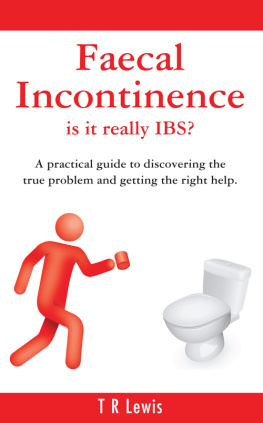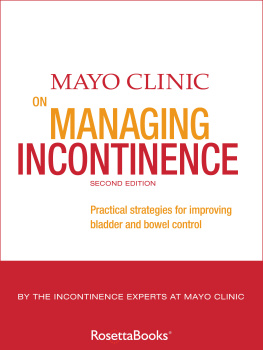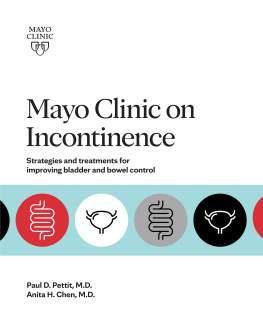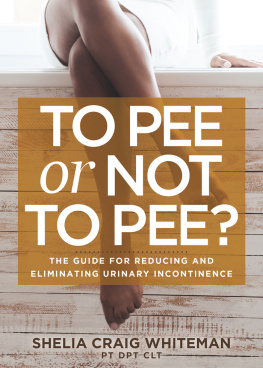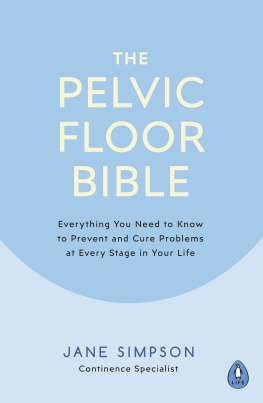An Addicus Nonfiction Book
Copyright 2008 by Michael H. Safir, M.D., Clay N. Boyd, M.D., and Tony E. Pinson, M.D. All rights reserved. No part of this publication may be reproduced, stored in a retrieval system, or transmitted in any form or by any means, electronic, mechanical, photocopied, recorded, or otherwise, without the prior written permission of the publisher. For information, write Addicus Books, Inc., P.O. Box 45327, Omaha, Nebraska 68145.
ISBN 978-1-886039-87-2
Cover design by Peri Poloni Gabriel
Illustrations by Jack Kusler
Typography by Linda Dageforde
This book is not intended to serve as a substitute for a physician. Nor is it the authors intent to give medical advice contrary to that of an attending physician.
Library of Congress Cataloging-in-Publication Data
Safir, Michael H., 1967
Overcoming urinary incontinence : a womans guide to treatment / Michael H. Safir, Clay N. Boyd, Tony E. Pinson.
p. cm.
Includes index.
ISBN-13: 978-1-886039-87-2 (alk. paper)
1. Urinary incontinenceTreatmentPopular works. 2.
WomenDiseasesTreatmentPopular works. I. Boyd, Clay N., 1961- II. Pinson, Tony E., 1961- III. Title.
RC921.I5S34 2008
616.62dc22
2007036266
Addicus Books, Inc.
P.O. Box 45327
Omaha, Nebraska 68145
www.AddicusBooks.com
Printed in the United States of America
10 9 8 7 6 5 4 3 2 1
Contents
Acknowledgments
My two most important roles are as husband to my wife, Robyn, and father to my children, Julia and Jack. I am the physician I have become because of their sacrifice and support. I honor my mentors, Shlomo Raz, M.D., Jack W. McAninch, M.D., and Anthony Schaeffer, M.D. This book is, in large part, the product of Frances Sharpe who has served as editor and who now knows more about incontinence than any layperson should.
Michael H. Safir, M.D.
I would like to acknowledge my wife, Dr. Bonnie Accardo Boyd, who has helped weather the storms both preand post-Katrina. I also want to thank Dr. Jack C. Winters for all of his energy and expertise, Dr. Richard Airhart for his integrity and determination throughout the storms, Dr. Rodney Appel for his practical role as a dynamic educator, Dr. Joseph Aloysius LaNasa, who has been both friend and mentor, and finally the patients, families, and medical staff throughout the River Parishes for their faith and commitment in rebuilding and supporting the recovering communities.
Clay N. Boyd, M.D.
I would like to thank my wife Lorna and my children Evan and Alec for their devotion, patience, and support of my professional and personal endeavors, which have often required sacrifice on their parts. Thank you to Cathy Kulpinski and the staff members of Pinson Urology and Continence Center for their tireless work in caring for our patients. I also wish to acknowledge the exceptional staff members of W.A. Foote Memorial Hospital, especially Judy Gillman and Nancy Wilkins. I am also indebted to my patients who inspire me on a daily basis. Finally I would like to thank Frances Sharpe for her editorial assistance in bringing this book to life.
Tony E. Pinson, M.D.
Introduction
M illions of women have urinary incontinence, but they rarely talk about it. Thats because the involuntary loss of urine can be so embarrassing that many women are too ashamed to discuss iteven with a doctor. This means that millions of women, and perhaps you as well, are suffering in silence from a condition that is treatable and, in some instances, curable. In fact, as many as 90 percent of women with incontinence avoid seeking medical help for the problem. Instead, you may alter your daily life, shying away from social occasions or stopping physical exercise for fear of wetting yourself. But you dont need to live your life this way. By seeking help and starting treatment, you may be able to return to your normal activities and enhance your quality of life.
The purpose of this book is to provide you with an easy-to-understand overview of incontinence and its causes, to encourage you to seek help from a medical professional, and to offer information on the numerous treatment options available. We hope this book will inspire you to stop accepting incontinence as a fact of life and start finding a treatment plan that works for you.
Part I
Incontinence: An Overview
Chapter 1
Understanding Incontinence
A re you frustrated because you cant always control when you urinate? When you cough or sneeze, are you worried that urine might leak out? When you feel the urge to urinate, are you afraid you wont make it to the bathroom in time? If so, you arent alone. Urinary incontinence is a common problem for millions of women. However, like many of these women, you may be too embarrassed to talk about it or even admit that you have a problem. In fact, you may feel that incontinence is something you just have to deal with. But it isnt! The more you understand about incontinence, the more youll realize that it isnt considered normal and it isnt something you have to tolerate.
Incontinence is simply the involuntary loss of urine. The amount of urine that leaks out and the frequency with which leakage occurs can vary greatly from woman to woman. You may dribble a few drops of urine, or you may experience uncontrollable wetting. You may experience leakage only occasionally, or you may find that its become an everyday occurrence. No matter where you fall in this spectrum, the loss of urine is a problem that should be addressed.
The Female Urinary System
The urinary system processes your bodys liquid waste by creating, storing, and eliminating urine. The system consists of the kidneys, the ureters, the bladder, the urethra, the urethral sphincter, and the pelvic floor muscles.
When the system is working normally, the kidneys filter the bodys liquids to create urine. The urine flows from the kidneys through two tubes called ureters that connect the kidneys to the bladder. The bladder stores the urine until you are ready to urinate. The urethral sphincter muscle is normally closed tightly to keep urine in the bladder until you are ready to urinate. The urethra is a short tube that carries the urine out of the body.
When you urinate, muscles in the bladder contract or tighten, forcing the urine out of the bladder. At the same time, the urethral sphincter and the pelvic floor muscles relax, causing the urethra to open to allow urine to flow through it. When your urinary system is working properly, you can delay urination when a bathroom isnt nearby. When you feel the urge to urinate but cant get to the bathroom, your pelvic floor muscles tighten to keep the urethra closed.
Normal urination also involves the nervous system. When your bladder is almost full, sacral nerves send a signal to your brain to alert you that it is time to urinate. Typically, the nerves send a signal before the bladder is completely full, giving you time to get to the bathroom while the bladder continues to fill.
Types of Urinary Incontinence
You may be surprised to discover that there are five types of urinary incontinence. Leakage is a symptom that is associated with all types of urinary incontinence. However, the things that trigger the leakage and the kind of leakage you experience (a few drops, a constant dribble, or the complete emptying of your bladder) depend on which type of incontinence you have. In some cases, you may experience more than one type of incontinence. The five different types of incontinence are: stress incontinence, urge incontinence/overactive bladder, overflow incontinence, functional incontinence, and mixed incontinence.
Next page


